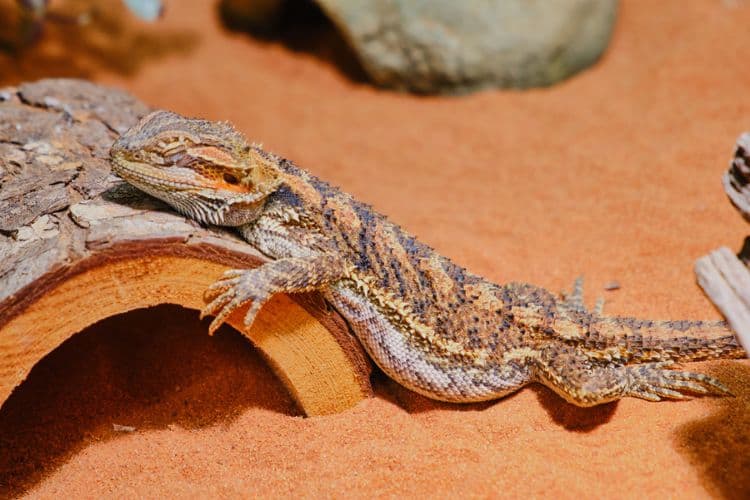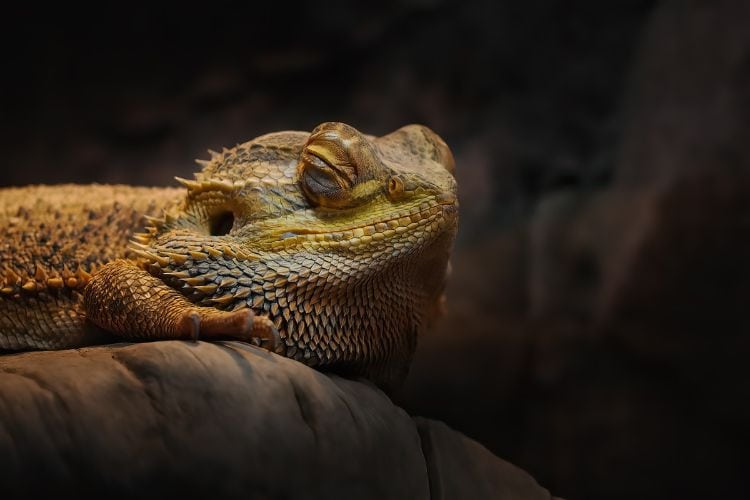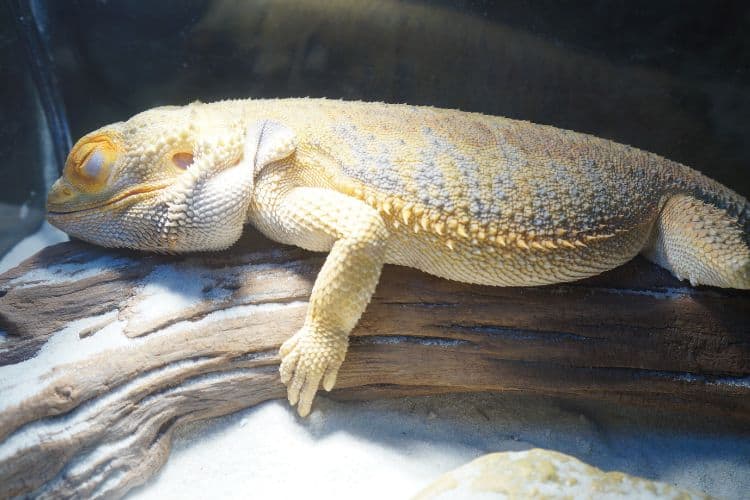When your beardie shifts from a bouncy friend to a lackadaisical grouch overnight, it’s normal to worry. Maybe Spike is sick, or has he initiated a mysterious hibernation-like state called brumation to ride out winter?
This comprehensive article will arm you with all the facts that will help you understand the hibernation-like state that many pet dragons adopt even with year-round perfect tank conditions.
Defining Bearded Dragon Brumation
Simply put, brumation represents dormancy for cold-blooded critters like reptiles. Just as mammals conserve energies in winter through hibernation, the brumation process allows bearded dragons to retreat underground to ride out Australia’s desert winters. It’s a completely natural process.
With frigid temperatures and scarce food from June through August, wild dragons literally hole up in burrows, barely moving for months. Even small forays expend precious fat reserves needed to emerge next spring.
Yet, strangely enough, captive dragons housed in climate-controlled enclosures often demonstrate this ancient tendency too. Despite having food, heat, light, and humidity perfectly regulated year-round, their innate biological clocks still signal “prep for seasonal shortage!” when external light/temperature patterns shift.
During full-blown brumation, metabolism, heart rate, and respiration rates plunge significantly. Appetite completely vanishes―after all, what’s the point in eating if you snooze for weeks straight? Strange as it seems to us mammals, reptiles evolved to handle long fasting.

When Does Bearded Dragon Brumation Usually Occur?
In Australia’s Southern Hemisphere, bearded dragon brumation hits during the mild winter months of June through August. But seasonal light changes more often trigger pet dragon dormancy residing in Northern Hemisphere homes.
Many U.S. dragons opt to initiate brumation from November/December through February, similar to North American winter months. Yet some decide to take a midsummer siesta too!
Age, gender, or random enclosure light/temperature fluctuations can all spur surprise brumation.
For example, Grace from Georgia first noticed her dragon Zeus sleeping soundly the entire month of October at nearly 2 years old. Then her friend Matt’s 7-month-old juvenile dragon Blue randomly began sleeping heavily in July―quite an atypical baby behavior!
The point is that bearded dragon brumation follows no guaranteed predictable seasonal schedule.
Once an individual dragon’s biological clock flips their hormonal switch and signals “hibernation mode,” nothing typically overrides it. External conditions no longer seem to matter, only their internal drive to conserve energy by sleeping for weeks on end!
How Long Do Bearded Dragon Brumations Last?
Brumation duration varies widely from dragon to dragon. Reported spans range from a couple of weeks up to eight full months in captivity. But generally, most bearded dragon brumations persist for around one to three months, similar to natural Australian winters.
Certain supersized adult males may snooze for four months or longer, while adult females often awaken earlier at the two-month mark. Older dragons also tend to take lengthier annual brumations compared to younger juveniles.
Wild dragons rely on seasonal cues like warming spring sunshine or emerging insect activity forcing them awake. Meanwhile, pet dragons more randomly conclude brumation since their enclosures already maintain suitable conditions year-round. It seems solely up to their individual bio clock when to rouse from slumber and get hungry.
Do Bearded Dragons Eat or Drink During Brumation?
Generally, bearded dragons refrain from eating, drinking, defecating, or moving much at all while deep in winter dormancy mode.
When metabolism drops so low, digestion shuts down, so consuming food provides zero energy without proper sunlight basking for processing.
That being said, veteran bearded dragon owners anecdotally report some dragons licking water bowls sporadically despite not fully emerging from brumation. And rarely, mostly asleep dragons even half-heartedly nibble greens or bugs during their winter snooze.
But certainly don’t expect any vigorous appetite or waste production—their organs run on minimal reserves during this energy-conserving period.

Early Signs Your Bearded Dragon Plans to Brumate
Gradual behavior shifts first signal your pet is biologically preparing for upcoming dormancy. Monitor the following 1-2 months before full brumation mode kicks in:
- Loss of Appetite ― Notice your once voracious dragon losing interest in staple greens, veggies, and worms they previously relished. Sensing shortened winter days ahead, metabolism naturally downshifts, needing less food for the next months.
- Increased Sleeping ― Expect to spot your pet napping more often in shaded hiding areas instead of watching the room’s action from their hammock or tree perch. Light and ambient warmth no longer provide the same energizing effects outside designated basking zones.
- Lethargic Movements ― With brumation approaching, your dragon will begin sitting still for longer periods rather than actively engaging with novel cage furnishings. Limited energy reserves now prioritize seasonal survival readiness over-enrichment.
- Seeks Shade and Isolation ― In these final weeks preceding dormancy, don’t take it personally if your pet shuns attention that previously delighted them! Your scaly child simply feels fewer urges to smell, see, or touch interesting stimuli as sensory needs decline upon entering conservation mode for winter.
- Ultimate Brumation Hideout ― Finally expect fading appetite, heat-seeking, and activity to culminate one day with your dragon permanently retiring to their designated cool hide box.
Is My Dragon Brumating or Dead?
While no reptile owner prefers a perpetually lifeless pet over a healthy hibernator, knowing the difference becomes critical. So what objective signs distinguish a thriving brumating dragon from a deceased one?
Signs your dragon is alive:
- Slow, shallow breaths observed under vigilantly still observation
- Perhaps slight movements when repositioned
- Cool body but not rigid limbs
- Moist mucous membranes
Signs your dragon is dead:
- No detectable breathing motion watching for multiple minutes
- Failure to reflexively respond if gently repositioned
- Glazed over, sunken eyes plus gaping mouth
- Stiffening joints as circulatory systems fail
If uncertain, seek emergency veterinary assessment.
Caring For a Brumating Bearded Dragon
While your scaly sidekick sleeps, you should sustain the safest brumation conditions by doing the following:
- Schedule Pre-Brumation Vet Visit ― One month before dormancy begins, arrange a wellness examination. Diagnose and address any parasites, weight loss, or early arthritis that could complicate a successful winter’s long nap. Feeling their best fortifies a smooth hibernation journey.
- Adjust Enclosure Conditions ― As outdoor temperatures fall, lower overall ambient temps closer to 60-65 F and basking spot zones around 80 F only during their shortened daylight hours. Disable intense overhead lighting to preserve a darker muted mood.
- Provide Designated Hide Box ― Outfit your beardie’s cage with an isolated opaque plastic hide hut, cork tunnel, or wooden box where they can completely avoid any disruptive stimuli while sleeping.
- Boost Humidity Gradually ― Slowly increase cool-end relative humidity to around 50-60% since brumating reptiles rely more heavily on absorbing environmental moisture through the skin and mucous membranes.
- Resist Handling Urges ― Don’t touch your bearded dragon unless you’re monitoring their breathing. Allow nature to take its seasonal course undisturbed.
- Spot Clean Waste ― Surprisingly, some brumating reptiles sporadically pass concentrated urates or feces during their intended extended fasting. Quickly remove the waste to prevent intestinal parasite spread or uremic toxicity in case your beardie’s kidneys slow down too severely.
Emerging From Brumation
When your scaly snoozer finally greets late winter by poking his head from hiding, thoughtfully welcome them back to the land of warmth and light:
- Gradually increase enclosure ambient and focal basking temperatures back to normal levels. Do so over a week.
- Reinitiate standard 10-14 hour daily visible light and UVB lighting schedules.
- Offer your beardie their favorite greens lightly coated with bee pollen first. Then reintroduce bugs in limited portions until appetite fully ignites.
- Coax voluntary soaking in tepid dechlorinated water for 15 minutes daily to rehydrate sluggish tissues.
Expect leftover lethargy, behavior disinterest, or stomach upsets for a week or two post-dormancy until digestion reignites. And, of course, persistent symptoms merit prompt veterinary investigation.
Potential Health Risks of Bearded Dragon Brumation
Why might an owner strongly consider blocking brumation under certain scenarios?
Turns out, allowing dormancy poses threats to physically and mentally compromised dragons. Brumation is only safe when entered after building robust energy reserves. Otherwise, health may spiral downward from the added stress of fasting.
Advanced age, chronic low weight, liver/kidney diseases, cancer, and infections can drain crucial resources needed to endure lengthy dormancy. Left undiagnosed or untreated, such issues become compounded by months of fasting semi-consciously.
Additionally, inadequately established juvenile dragons lack needed fat storage compared to most adults. And putting a generally healthy yearling through their very first brumation can be risky.
Reasons to Medically Prevent Bearded Dragon Brumation
Some scenarios necessitate overriding dormancy for your beardie’s health sake, through veterinary guidance, of course:
- If Bearded Dragon Is Under 1 Year Old ― Babies and juveniles shouldn’t endure months-long fasting periods because they can stunt their rapid growth.
- If Symptoms Suggest Illness ― Draining resources through dormancy exacerbates any brewing infection or disease often masked by subtle appetite and activity changes also seen in early brumation.
- If Sudden Unexplained Weight Loss Precedes Dormancy Attempt ― Rapid fat loss by itself suggests a pathological process requiring diagnosis before resources deplete further over months of brumation.
- If Your Beardie Is Attempting Summer/Winter Brumation ― Off-season timing sparks concern for low temperatures, light deficiencies, or other husbandry factors triggering abnormal biology that’s misleading the body about optimal times to conserve energy.
In the above scenarios, you must correct any husbandry issues behind unhealthy brumation attempts―commonly inadequate heat, light spectrum or intensity, or insufficient hydration/nutrition.
If blocking brumation is medically advised, veterinarians can coach disruption tactics to rouse reluctant dragons through uncomfortably warm temperatures and unrelenting daylight exceeding their biological drive to sleep.
Success requires resolutely handling a sleepy dragon daily, gently coercing them to accept sustenance again no matter how disinterested they act.
Some dragons resent the perceived harassment, however, refusing food altogether when stressed by blocked dormancy attempts against their ambitions.
You must tread these waters very carefully, guided by a veterinarian.

Will My Bearded Dragon Survive Brumation?
When properly prepared beforehand by correcting any low weight or husbandry issues, mature dragons nearly always revive from standard winter dormancy. Their resilient reptile bodies evolved thriving through countless generations of seasonal harshness, after all.
However if your dragon seems extra sluggish post-brumation despite ideal care, and if appetite or personality fail to bounce back within two weeks, extend extra patience and support.
Persistent lethargy could signal depleted resources that cage enhancements alone cannot replenish fast enough. In such scenarios, professional assistance could help your dragon recover.
Never hesitate to pursue medical guidance sooner than later in the rare event of an outwardly healthy dragon demonstrating functional losses or personality changes lasting more than a month after dormancy concludes.
Wrapping Up
Rest assured, healthy adult dragons nearly always continue thriving through seasonal downtime their genes prepared them for over millennia.
Through attentive tracking of appetite, bowel movements, energy levels, scale/skin integrity, and responsiveness, you can easily distinguish normal dormancy from deficiency state flags.
Make sure to sustain your dragon’s habitat needs during dormancy without accidental disruption and to reward revived spring activity with hearty feasts, new toys, and extra handling until summer sunshine flows freely again.

